Red cabbage is a johnnie-come-lately at my festive feast. I don't remember it featuring in my childhood, but in recent years my sister has sneaked it on to the menu – though personally, I still prefer it with the Boxing Day ham. It seems to occupy the same space as carrots or the yule log: not strictly canonical, but not entirely unwelcome either. In Denmark, however, where they tend to roast richer meats such as pork or duck, spiced red cabbage occupies the same pole position as our brussels sprouts – except it's rather more popular. But whether you serve it up with the turkey, or save it for the next day, it's a shoo-in for some point in the Christmas calendar: after all, it's red (very festive), sweetly spiced (see also: mince pies and mulled wine), and best of all, it only gets better with age.
The cabbage
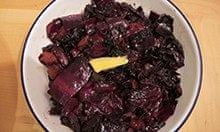
Most people shred theirs, but Jamie Oliver cuts it into "irregular chunks", which I prefer; it makes the dish look more interesting and gives it a better texture. Nigel Slater and Trish Hahnemann, author of Scandinavian Christmas, both saute their cabbage in fat (oil for him, butter for her) until "bright" and "shiny" before turning the heat down and gently braising it until tender. Although the cabbage is cooked through, even soft, this technique seems to help it retain its structural integrity; I'm not a fan of a jammy mush.
Bit players
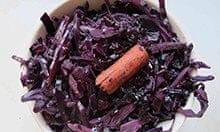
Delia Smith, Hahnemann, Signe Johansen and Oliver use onions in their red cabbage, with Smith chucking in garlic too, but I like the red onion preferred by Emma Lewis in Good Food magazine; the sweetness works well in a dish which is, I decide after helping number four, all about the interplay of sweet and sour ingredients.
The sour or sharp element is often at least partly supplied by an apple: Smith uses a cooking variety, but Johansen and Oliver's dessert version holds up better to long slow cooking, rather than dissolving into apple sauce. Go for something sharp, such as a cox or a granny smith, rather than a sweet red fruit.
Oliver puts bacon in his red cabbage, a throwback to Eliza Acton's "red cabbage stewed in the English manner" from 1845, which uses ham. Though the two are, of course, flavour soulmates, after an hour's cooking the bacon has all but disappeared, and adds little to the finished dish. Better to serve it with pork.
The liquid

Braising requires liquid – and vinegar is the most popular choice (Acton chooses beef stock, but I'm not keen on the idea with turkey). Oliver plumps for balsamic, Smith and Lewis for wine and Johansen and Slater for cider vinegar (Hahnemann is the only one to omit this souring element). I'm surprised to find, though cider seems the most natural choice with the apples, that balsamic adds something extra: the intense, caramelised sweetness is entirely in keeping with the flavour profile of the dish as a whole. It may not be traditional, but hey, even Christmas has to keep up with the times.
Instead, Hahnemann uses blackcurrant cordial; in fact, I came across her recipe when a friend claimed the best red cabbage she'd ever eaten had been made with Ribena. Lewis does something similar with port and water, while Johansen adds a glass of red wine. I find the first two a little too sweet for my taste: Johansen's is better balanced, but I'm not sure the dish needs the extra liquid – I prefer it drier.
Flavourings

That said, a little sugar is a must – rich muscovado for preference – to help balance the vinegar. Johansen also stirs in some lingonberry jam, although she suggests using blackcurrant, redcurrant jelly or cranberry sauce as a more British alternative. As it's Christmas, I go for the last, and discover the slightly sour, fruity flavour is perfect here, giving the dish a chutney-like quality which will endear it all the more to anyone with a thick slice of baked ham on their plate.
The spices used to tend to be the usual festive subjects – cinnamon, cloves, nutmeg – though Oliver goes for fennel seeds and Slater for juniper berries. These both work well, but not with turkey – save them for January. Lewis adds orange zest and juice, which, though a nice idea, is slightly over-egging the Christmas pudding. If you are serving it with ham, however, a little grating of zest on top to serve wouldn't go amiss, as much for the colour as anything else.
The cooking
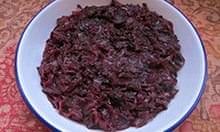
Smith bakes hers, but this doesn't seem to add anything, except time. Though I find Slater's 20 minutes too little for truly softening the cabbage, I can't quite get over my horror of overcooked brassicas. Somewhere between Oliver's hour and Johansen's hour and a half seems to be the sweet spot, but keep testing it until it meets your particular textural requirements.
To finish
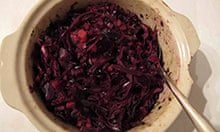
Hahnemann stirs a spoonful of duck fat through her cabbage, which, though I like the richness, I'm not particularly sold on flavourwise – I prefer Oliver, Smith and Lewis's butter. But then I'm not Danish, as will probably be evident from the recipe below; a cabbage punchy enough to serve with ham or goose, but which would bed down pretty nicely with a turkey too. Each to their own at Christmas, after all.
The perfect red cabbage
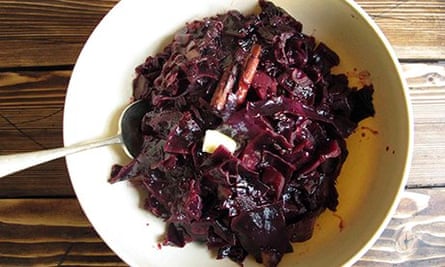
(Serves 6-8)
50g butter, plus extra to serve
1 red onion, finely chopped
1 cinnamon stick
¼ tsp ground cloves
¼ tsp ground nutmeg
1 red cabbage, cored and cut into irregular chunks
1 sharp eating apple, finely chopped
3 tbsp muscovado sugar
150ml balsamic vinegar
2 tbsp cranberry sauce
Melt the butter in a large pan over a medium heat and add the onion. Soften in the butter for a few minutes, then stir in the spices and cook for one minute.
Tip in the cabbage and saute until shiny and well coated. Add the apple, sugar and vinegar, reduce the heat to low, stir well, cover and cook for 45 minutes, stirring occasionally to ensure it doesn't stick.
Stir in the cranberry sauce and cook for another 25 minutes. Season well and stir through a knob of butter before serving. You can also store it somewhere cool for a couple of days, then reheat to serve, if you prefer, adding the butter during the reheating.
Red cabbage: does it have a place at the Christmas table, or is it one for the next day – and what other slightly unusual things would you not be without on 25 December?
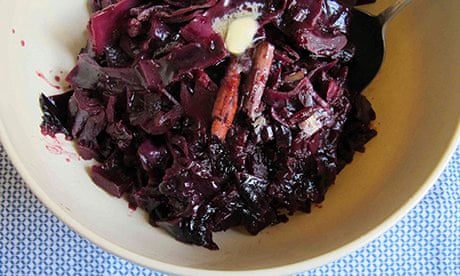
Comments (…)
Sign in or create your Guardian account to join the discussion